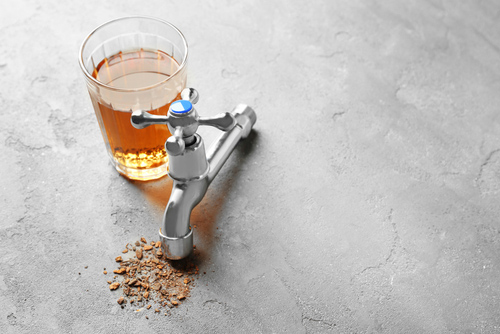
Why Is My Tap Water Yellow?

If your tap water has developed a yellow hue, it’s a sure sign that something is wrong, particularly if you see signs of sediment in your water. It could mean there’s rust in your water line.
Corrosion often dislodges when municipal flow rates are interrupted. This can happen when your municipality flushes your utility, or your fire service connects to your mains. It could also indicate that someone has illegally connected to your mains.
Let’s look at the most common signs of water yellowing.
1. A Rusty Water Heater
If your hot water is discolored, but your cold water is clear, you probably have rust buildup in your hot water tank. While a simple flush should give you clearer water temporarily, don’t drag your feet on a repair.
Corrosion can lead to severe leaks. It could also move into the smaller components of your hot water system, causing additional damage that will ultimately require repair.
2. A City Water Flush
If your water turned yellow suddenly, your utility company may have flushed their mains to remove accumulated rust from your pipes. The water should turn clear quickly and is generally safe to drink. The presence of iron is rarely hazardous.
If you’re unsure, call your municipality to find out if they’re currently meeting the EPA’s maximum iron content limits. Large amounts of iron can lead to iron poisoning. A hydrogen peroxide system can remove rust from your water if the problem is recurring or particularly severe.
3. Impure Well Water
Iron bacteria forms when iron and manganese combine with bacteria to create sludge-like deposits. This can cause blockages in your washing machine and water heater, shortening their life spans and reducing water pressure.
Yellow well water is a sign of manganese content and decaying vegetation. You should install an iron filter to prevent the staining of your ceramics and clothing. Air injection oxidation systems can remove ferric and dissolved iron.
4. Tannins
Tannins are the result of decaying vegetation and peaty soil. They’ll give your water a tea-colored hue and a musty smell. If your water tastes bitter, this is probably the culprit. While tannins are safe to drink, they’re only delicious in tea and wine.
You can address tannin content by investing in an ion exchange system or water softener. Activated carbon filters are equally helpful, removing 99% of all tannins. While reverse osmosis systems can help, they also remove valuable minerals from your water.
5. Rusty Pipes
Rusty pipes and water lines tend to wash sediment and metal into your water. You can safely diagnose your problem as corrosion if you see orange or yellow particles. If your water runs yellow but turns clear within a few seconds, your indoor pipes are probably the culprit.
There’s only one solution: to replace the affected pipes. This requires some investment, but modern camera inspections and trenchless repairs can significantly reduce the cost.
Schedule Water Treatment Services With Primo Plumbing, Inc.
Most yellowed water is safe to drink, but that doesn’t mean it tastes pleasant. Iron adds a metallic flavor and can be highly destructive to your fixtures. Comfort-Air Engineering and Primo Plumbing, Inc. will address the problem with our water softening solutions.
We rely on three forms of water softeners: ion exchange, dual-tank, and salt-free equipment. Unlike water filters, softeners remove only the offending “hard” minerals. After treatment, your water will be clear and fresh-tasting.
Call (210) 494-1691 to schedule water treatment services in San Antonio, TX, or nearby.






